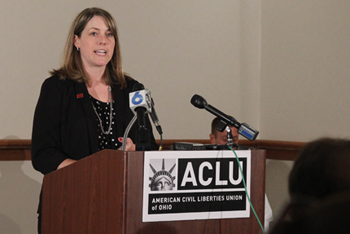Featured Work

A Call for Justice: ACLU of Ohio’s Pay-to-Stay Press Conference
ACLU of Ohio regional director Adrienne Gavula addresses the press and opens up the event.
ACLU of Ohio senior policy director Mike Brickner speaking about the predatory practice of pay-to-stay fees
"We can’t hope to balance our budgets on the backs of low income people. First of all, it’s bad policy but second of all, it just won’t work. These people can’t pay and when we force them to and when we put up barriers, we make it harder for them to actually be successful and we only hurt ourselves and our community."
Reporters listen as Brickner explains the cyclical trap many Ohioans are snared into after being charged pay-to-stay fees.

Pay-to-Stay Jail Fees: The Newest Way People Are Profiting Off Mass Incarceration
“There are so many other factors. There are so many other consequences. It’s not even just about the retribution portion of being incarcerated. There is so much after the fact to deal with and to just try to get things together.”
– Michael W. Geauga County
Pay-to-stay fees bring an avalanche of financial, mental, and emotional stress for people after their release from jail. Michael W. of Geauga County depicts his struggles with these debts.
“I was doing pretty well and my credit score was high for my age, but once this occurred, I had lawyer fees. I had to pay thousands of dollars to take care of this and went into debt. When I got out I had to take care of myself, but I didn’t have anything anymore.
“I’m up to here in my eyeballs and then I get these emails saying ‘your credit score is dropping, your credit score is dropping.’
“I’ve looked into declaring bankruptcy, but it costs money to even do that. I’m kind of stuck for right now, just barely getting by. I think, if I can get the $700 together then I can declare bankruptcy and all the debt can be just gone and it can finally be off my shoulders. But right now I’m looking at, like, on top of the thousand that I owe them, I’ve got another $20,000 on my cards. And most of it was just lawyers.
“I had been couch surfing for about a month. My parents couldn’t handle me. My girlfriend, fiancé couldn’t handle me. It was like, I still don’t know.
“I used to have dreams that I was back in there. And I couldn’t stay at my parents place anyways because I slept in the basement and its cinder block walls. I’d wake up and think I was in jail again and I’d lose it. I couldn’t deal with it.”
Michael’s story is one of many. The details may vary but the common thread of disruption and struggle are the same.
Expectations Versus Reality
Many of us expect formerly incarcerated people to resume normal lives after serving time in jail. But this assumption neglects the need for continual support to reintegrate successfully. Adding debt onto a person who may already be struggling to succeed is a recipe for failure. These fees don’t add up either, providing very little in terms

